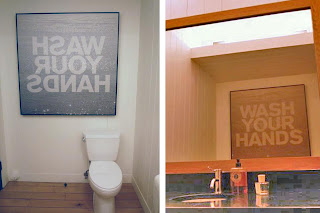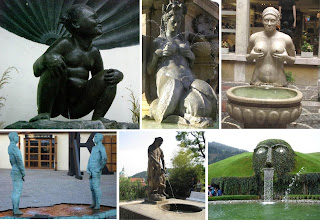Monday, May 31, 2010
Screen goddess
Posted by
jim and Mary
at
6:59 AM
![]()
![]()
Labels: public sculpture
Saturday, May 29, 2010
Dutch courage
Posted by
jim and Mary
at
6:59 AM
![]()
![]()
Labels: Look alike
Friday, May 28, 2010
on the road
Posted by
jim and Mary
at
11:57 AM
![]()
![]()
Labels: on the road
Presto
Posted by
jim and Mary
at
6:53 AM
![]()
![]()
Labels: architecture
Thursday, May 27, 2010
Creed is good
Posted by
jim and Mary
at
6:59 AM
![]()
![]()
Labels: installation, Look alike
Wednesday, May 26, 2010
When opposites attract
Posted by
jim and Mary
at
6:52 AM
![]()
![]()
Labels: dealer gallery, painting, style
Tuesday, May 25, 2010
Judgment day
Page work
Posted by
jim and Mary
at
6:59 AM
![]()
![]()
Labels: dealer gallery
Monday, May 24, 2010
Random post
Posted by
jim and Mary
at
6:55 AM
![]()
![]()
Labels: collecting, Te papa
Saturday, May 22, 2010
Bad wrap
Posted by
jim and Mary
at
6:42 AM
![]()
![]()
Labels: art in adland, copy cat
Friday, May 21, 2010
Bunker dreams
Posted by
jim and Mary
at
5:54 AM
![]()
![]()
Labels: dealer gallery, et al.
Thursday, May 20, 2010
Crush
Wednesday, May 19, 2010
The prestige
Posted by
jim and Mary
at
6:41 AM
![]()
![]()
Labels: exhibitions, Look alike
Tuesday, May 18, 2010
Monday, May 17, 2010
Looking at...
Posted by
jim and Mary
at
11:57 AM
![]()
![]()
Labels: Look alike
How to look at a painting
Posted by
jim and Mary
at
6:59 AM
![]()
![]()
Labels: exhibitions
Saturday, May 15, 2010
Googling on
Posted by
jim and Mary
at
6:56 AM
![]()
![]()
Labels: google, painting, publishing
Friday, May 14, 2010
Washed up
Thursday, May 13, 2010
A piece of work
Image: work by a contender in Work of Art: The Next Great Artist
Wednesday, May 12, 2010
Paton place
Exhibitionists
Posted by
jim and Mary
at
6:59 AM
![]()
![]()
Labels: curators, display, exhibitions
Tuesday, May 11, 2010
Space travel
Posted by
jim and Mary
at
6:56 AM
![]()
![]()
Labels: dealer gallery, warhol
Monday, May 10, 2010
Beating the drum for history
Posted by
jim and Mary
at
6:58 AM
![]()
![]()
Labels: dashper, exhibitions, sculpture
Saturday, May 08, 2010
Whale watch
Posted by
jim and Mary
at
6:56 AM
![]()
![]()
Labels: animal art
Friday, May 07, 2010
Things past
Posted by
jim and Mary
at
11:59 AM
![]()
![]()
Labels: koons, things past
Poor prints
One of the repros we saw up for sale was The painter on the road to Tarascon by Vincent van Gogh rather casually titled on the back Man on the way to work. It’s rather poignant to note that this reproduction was out on loan as late as May 1975. If the borrower had held out for a couple of months, he or she could have checked out the real thing in the exhibition Van Gogh in Auckland at the Auckland City Art Gallery.
The other poignant thing about The painter on the road to Tarascon is that the original of was lost during the Second World War when allied bombing set fire to the Kaiser-Friedrich Museum in Magdeburg. Other copies do exist, well versions really, they were painted by Francis Bacon in 1957. In an art-in-the-movies moment, it is said that Bacon saw the film Lust for life, which was released late in 1956, and based his composition on a sequence of Kirk Douglas as Van Gogh walking along the road. Bacon went on to make a number of paintings based on the Van Gogh. One of them, painted in 1985, he sent on long-term loan to Arles for the 100th anniversary of Van Gogh’s stay this. This month, battle is being waged in the courts as the Bacon estate try to have this painting returned. You can buy a reproduction of the Lust for life poster here.
Posted by
jim and Mary
at
6:58 AM
![]()
![]()
Labels: art in the movies, editions, Look alike
Thursday, May 06, 2010
Bottled
Posted by
jim and Mary
at
11:59 AM
![]()
![]()
Labels: public sculpture
Where’s Walters?
You can read some of the Turner response here
Posted by
jim and Mary
at
6:56 AM
![]()
![]()
Labels: auckland art gallery, Walters Prize
Wednesday, May 05, 2010
Do I hear 149 million?
Cut and run
Posted by
jim and Mary
at
6:59 AM
![]()
![]()
Labels: mccahon, publishing
Tuesday, May 04, 2010
Don’t worry, be happy
.
Monday, May 03, 2010
Four you
Posted by
jim and Mary
at
2:59 PM
![]()
![]()
Revelations 1
Eye pod
Posted by
jim and Mary
at
6:54 AM
![]()
![]()
Labels: public sculpture
























































